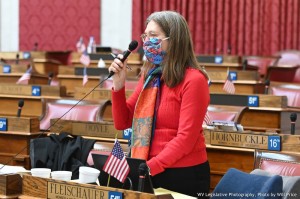From the WV Rivers Coalition, Charleston, December 10, 2020
Yesterday, the Joint Legislative Rulemaking Review Committee met to debate updates to the human health criteria in our water quality standards. This committee meets before the regular session to review, amend and vote on recommended rules for the full Legislature’s consideration.
West Virginia Rivers’ executive director, Angie Rosser, testified before the committee to make sure your voice was represented. She pointed out the hundreds of you who took action to say no more toxins and cancer-causing chemicals in our waters. While at the committee meeting, Angie learned that this rule had more public interest and participation than any other rule the committee had reviewed.
During her remarks, Angie urged the committee not to increase risk to public health, but to focus on reducing risk. A timely and compelling argument in light of Tuesday night’s fatal explosion at the Chemours chemical plant along the Kanawha River in Belle, WV. The Chemours explosion is a stark reminder that West Virginians are at constant risk from these dangerous chemicals and the inaction from the WVDEP and WV Legislature to adequately protect their constituents is an affront that should not be overlooked.
Sadly, even after 494 of you reached out to members of the committee in support of protective water quality standards, they decided to support less stringent limits for 13 toxins in our water quality standards.
Fortunately, there were a few Legislators who stood up for protective water quality standards. During the committee meeting, Delegates Barbara Fleischauer (D-Monongalia) and Larry Rowe (D-Kanawha) led the charge to fight against weakened standards. They spent over an hour questioning WVDEP on why they only chose a small subset of the recommended criteria to update and for information about the harms and risks these toxins pose to our residents.
Delegates Fleischauer and Rowe and Senators Baldwin and Jeffries sponsored an amendment to strip out the updates that would weaken human health criteria. That amendment was defeated 4-7, with Fleischauer, Rowe, Baldwin, Jeffries voting for the amendment and Foster, Sypolt, Butler, Martin, Steele, Rucker and Weld voting against it on a roll call vote.
In the final vote to pass the rule, Fleischauer and Rowe spoke against the rule as it would weaken water quality standards. The rule passed 7-4 along the same lines that the amendment failed.
So what now? The full West Virginia Legislature will consider and vote on water quality standards rule when they commence in February. WV Rivers will be there to keep you informed and be your voice throughout the session. The fight for protective water quality standards is going to be an uphill battle, and every one of you will be essential to keeping the pressure on the Legislature. We’re going to have to work hard to ensure health and waters are adequately protected – get ready!
#####. #####. #####. #####. #####.
See also: West Virginia’s streams are in trouble – Appalachian Mountain Advocates
More than 40 percent of West Virginia’s rivers are too polluted to pass simple water-quality safety thresholds. They are too polluted to be safely used for drinking water or recreation, or to support healthy aquatic life.
This is due in large part to pollution from decades of mining. From ongoing pollution from active mountaintop removal mines and toxic discharges from poorly reclaimed mines, the quality streams of West Virginia has never been more degraded.
According to the 2012 Draft West Virginia Integrated Water Quality Monitoring and Assessment Report by the West Virginia Department of Environmental Protection, less than a quarter of West Virginia streams fully support all or some of their assessed uses.
The state has failed to collect sufficient data to determine the health of 36 percent of the streams in the state.

